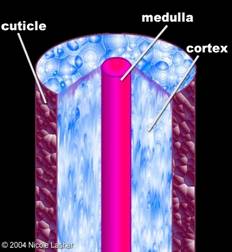HAIR OR FUR?

More often than not we use the terms hair and fur interchangeably. But, is there a real difference? Simply stated, there is no scientific distinction. Having hair or fur is characteristic of being a mammal. The hair of different animals is sometimes given different names like whiskers, bristles, quills, fleece or fur.
All hair or fur is a protein (called keratin), and is composed of dead epidermal cells. It grows from follicles embedded in the skin (dermis) of all mammals. In humans each follicle generally produces a single hair. In many other animals the follicles can produce several hairs. If you must separate the two, this is probably as good a distinction as you’re going to get between hair and fur.
Let’s take a look at hair first, there are many definitions. Hair has simply been defined as…
√ A mass of fine flexible protein strands that grow from follicles on the skin of a person or animal.
√ A covering for the body consisting of a dense growth of threadlike structures.
√ A coat of proteinaceous material that provides for certain functions: insulation, protection, sexual attraction.
 Examining a strand of hair, with the naked eye or
Examining a strand of hair, with the naked eye or
a hand magnifier would give the impression that it was a simple one piece structure. A cross section of the structure, examined under a microscope reveals that hair is actually composed of three layers.
The outer layer or cuticle, consists of a single layer of colorless keratinized cells which gives the hair its natural shiny appearance. The middle layer or cortex is the thickest layer of the hair and contains the pigment cells (melanocytes) of the hair which gives it color. The inner-most layer called the medulla (pith) contains a soft layer of proteins and also contains a few pigment cells.
It is this layer that gives hair its elasticity.
The medulla, the inner most layer is of special significance to fly tiers. We all know that some animal hairs are hollow. They are important to tiers because of their floatability. They hollow hairs are found on wild game animals that live in colder climates; deer, elk, moose, caribou, antelope, polar bear, etc. The medulla of the hair shaft in these animals is a series of air filled honeycomb chambers.

Now let’s look at fur. Once again there are many different definitions, depending on who you’re talking to. Fur is defined as…..
√ A thick coat of body hair.
√ The fine, soft body hair of non-human mammals.
√ The skin of certain animals, as the sable, ermine, or beaver, covered
with such a coat, used for lining , trimming , or making garments.
√ The body hair of non-human animals.
Fur consists of a combination of stiff, oily guard hairs on top and a thick under fur beneath. The guard hairs shed moisture, and the underfur acts as an insulating blanket that keeps the animal warm. The term fur relates to the density and softness of the hair rather than to a particular pattern of growth. Growth patterns are controlled by genetics.
For the purpose of fly tying terminology I’ve always used the following criteria to determine which label to use. If the hide of the animal as more guard hair than underfur, like a deer or moose, then I refer to it as hair. If the animal hide has more underfur than guard hair, like a muskrat or beaver, then I refer to it as fur.
See you on the Water…..

Tom Deschaine hails from Michigan where he maintains a website
dedicated to old Michigan dry flies. He travels the country fishing,
tying flies and writing articles for various internet sites.
~www.michigandryflies.net~
Copyright2011©Deschaine
